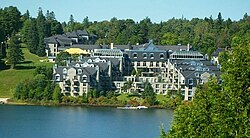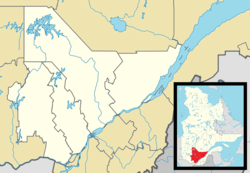Sainte-Adèle: Difference between revisions
Computrip2 (talk | contribs) The history of Ste. Adele should also include hotel, The Ste. Adele Lodge and its history.. |
Undid revision 769478307 by Computrip2 (talk) Unsourced |
||
| Line 76: | Line 76: | ||
In 1991 the railway was decommissioned and converted to a park for cyclists and skiers. The town has since abandoned the tourism industry in favour of residential development. [[Sony Pictures Entertainment]] partially filmed ''[[Snowboard Academy]]'' here in 1997. In 2006 and 2007 respectively, both ski hills in the village centre were closed, the North side of the Chantecler ski hill remains open as does Mont Gabriel . Also during this era, more land was being used for condominium complexes, attracting more permanent residents to the area. |
In 1991 the railway was decommissioned and converted to a park for cyclists and skiers. The town has since abandoned the tourism industry in favour of residential development. [[Sony Pictures Entertainment]] partially filmed ''[[Snowboard Academy]]'' here in 1997. In 2006 and 2007 respectively, both ski hills in the village centre were closed, the North side of the Chantecler ski hill remains open as does Mont Gabriel . Also during this era, more land was being used for condominium complexes, attracting more permanent residents to the area. |
||
'''Ste. Adele, Ste. Adele Lodge and Hills 40/80''' |
|||
The original location of the Ste. Adele Lodge was occupied by l’Hotel Rochon from 1910-1928. In 1928 its name was changed to La Maison Blanche and it operated until 1939. In 1939 a Montreal businessman Tom G. Potter, bought the old Maison Blanche, demolished it and in its place sprang The Ste. Adele Lodge. |
|||
The hotel consisted of the main building with an attached structure called the Red Room, which was a bar and dance hall and got its name from the red cement polished floor. Facing north behind the main hotel was a building called The Cedars with deluxe hotel rooms and on the right, a building called The Pines containing less expensive rooms and the machinery for the Olympic size swimming pool that was located next to it. |
|||
Just a few yards north of the swimming pool were the tennis courts and the entire complex was ringed with twelve houses that guests could rent. The swimming pool with its three diving boards was the largest pool in Quebec outside Montreal. Mr. Potter also developed two ski hills behind the hotel, Hills 40 and 80. The initial charge for day skiing was $0.50 and later rose to $1.00. |
|||
In approximately 1940 or 1941, Tom Potter, Joe Ryan, a New Yorker who owned Mont Tremblant ski resort, and Emile Cochand, owner of Chalet Cochand, purchased a used army truck and converted it into a huge snow plough. This truck kept the highway open from St. Jerome north to Mont Tremblant for several years until the Quebec Government took it over. The three of them, together with the rest of the members of The Laurentian Hotel Owners Association, were major players responsible for the development of the ski industry in the Laurentians and the growth of the ski trains from Montreal every weekend. |
|||
Mr. Potter set aside permanent rooms in the Ste. Adele Lodge to be used by military personnel who were injured and recovering from their wounds. Many people staying in these special rooms in the hotel were air force personnel. One was Pilot Officer George “Buzz” Buerling. He was a famous Spitfire fighter pilot who despite being shot down three times, twice in the Battle of Britain, ended up shooting down 32 German planes, a good number of them over Malta. He was Canada’s most decorated fighter pilot who died in an airplane accident in Rome, Italy. |
|||
During the summer of 1942, Mr. Potter hired the Johnny Holmes Band that played on CBC Radio. One of the feature attractions was Oscar Peterson on the piano. |
|||
In the 1943-1944 era, Mr. Potter put on a swimming charity event called Wings for Britain. He hosted the Canadian swimming championships and personally paid for swimmers from all over Canada also including a large American team. He covered every one’s expenses, paid for all the medals and raised enough money to help purchase a Spitfire fighter plane for the war effort. After his death, the Ste. Adele Lodge was sold to a company who changed the name to Le Montclair which later burned down. The site has now been developed into a beautiful municipal park. |
|||
In 2009, municipal taxes were doubled to what they were in the early 1990s to reflect the high demand for real estate that has been experienced in the municipality in recent years, and the beautiful landscape is now dotted with condos and strip malls, including the 500th [[Tim Hortons]] donut shop in Canada. |
In 2009, municipal taxes were doubled to what they were in the early 1990s to reflect the high demand for real estate that has been experienced in the municipality in recent years, and the beautiful landscape is now dotted with condos and strip malls, including the 500th [[Tim Hortons]] donut shop in Canada. |
||
Revision as of 23:57, 9 March 2017
Sainte-Adèle | |
|---|---|
 Downtown Sainte-Adèle | |
 Location within Les Pays-d'en-Haut RCM. | |
| Coordinates: 45°57′N 74°08′W / 45.950°N 74.133°W[1] | |
| Country | |
| Province | |
| Region | Laurentides |
| RCM | Les Pays-d'en-Haut |
| Constituted | August 27, 1997 |
| Government | |
| • Mayor | Robert Milot |
| • Federal riding | Laurentides—Labelle |
| • Prov. riding | Bertrand |
| Area | |
| • Total | 125.30 km2 (48.38 sq mi) |
| • Land | 120.90 km2 (46.68 sq mi) |
| Population (2011)[3] | |
| • Total | 12,137 |
| • Density | 100.4/km2 (260/sq mi) |
| • Pop (2006–11) | |
| Time zone | UTC−5 (EST) |
| • Summer (DST) | UTC−4 (EDT) |
| Postal code(s) | |
| Area code(s) | 450 and 579 |
| Website | www |
Sainte-Adèle (French pronunciation: [sɛ̃t adɛl]) is a municipality in Quebec, Canada, and is part of the Les Pays-d'en-Haut Regional County Municipality. It lies on the Route 117 (Trans-Canada Highway) about 70 kilometres (43 mi) north-west of Montreal. Its tourism-based economy centres on its skiing and hotel industry. Sainte-Adèle had a population of 12,137 as of 2011.[4]
History

In 1842 Augustin-Norbert Morin purchased land in the area that would become Sainte-Adèle for 8¢ per arpent, which colonists arriving soon after then purchased from him for $8 CAD per arpent. The town of Sainte-Adèle was founded in 1855. A rail line was constructed and the first Canadian Pacific Railway train arrived in the town in 1891. The railway was used primarily to transport wood, cattle, dairy products, and mail.
The first "ski resort", Chalet Cochand, was built in 1914, followed by The Alpine Inn in 1924. More hotels and expansions of local ski slopes followed. Sainte-Adèle's local newspaper, Le Journal des Pays d'en Haut, was established in 1967. Supporting the thriving hotel and resort business of the time, the École Hôtelières des Laurentides (Hotel School of the Laurentians) opened in 1983.
In 1991 the railway was decommissioned and converted to a park for cyclists and skiers. The town has since abandoned the tourism industry in favour of residential development. Sony Pictures Entertainment partially filmed Snowboard Academy here in 1997. In 2006 and 2007 respectively, both ski hills in the village centre were closed, the North side of the Chantecler ski hill remains open as does Mont Gabriel . Also during this era, more land was being used for condominium complexes, attracting more permanent residents to the area.
In 2009, municipal taxes were doubled to what they were in the early 1990s to reflect the high demand for real estate that has been experienced in the municipality in recent years, and the beautiful landscape is now dotted with condos and strip malls, including the 500th Tim Hortons donut shop in Canada.
Municipal history
The municipal status of Sainte-Adèle and the surrounding areas was the subject of personal, local, provincial, and national politics several times in its history. A coarse timeline of these divisions and fusions follows:
- 1918: Mont-Rolland is separated from Sainte-Adèle and created as a factory town.
- 1922: Val-Morin becomes an independent municipality.
- 1922: Sainte-Adèle was divided into the municipalities of Sainte-Adèle-en-Haut and Sainte-Adèle-en-Bas along class lines.
- 1948: Owners of the Chantecler Hotel petition the Ministère des Affaires municipales for the right to create the Village of Chantecler.
- 1951: Sainte-Marguerite-Station demands the right to secede from Sainte-Adèle.
- 1954: The Mont-Gabriel becomes a municipality with only nine citizens.
- 1964: Sainte-Adèle-en-Haut and Sainte-Adèle-en-Bas are reunited.
- 1967: Village de Séraphin is created.
- 1968: Part of Mont-Rolland (Sommet Bleu) is annexed by Sainte-Adèle.
- 1981: Mont-Gabriel becomes part of Mont-Rolland.
- 1997: Sainte-Adèle and Mont-Rolland are rejoined.
Sainte-Adèle was the setting of the long-running Quebec television series Les Belles Histoires des pays d'en haut, an adaptation of Claude-Henri Grignon's novel Un Homme et son péché.
Demographics
Population trend:[5]
- Population in 2011: 12137 (2006 to 2011 population change: 14.1%)
- Population in 2006: 10634
- 2001 to 2006 population change: 15.4%
- Population in 2001: 9215
- Population in 1996: 8719
- Sainte-Adèle (Ville): 5837
- Mont-Rolland (Village): 2882
- Population in 1991:
- Sainte-Adèle (Ville): 4916
- Mont-Rolland (Village): 2449
Private dwellings occupied by usual residents: 5781 (total dwellings: 7193)
Mother tongue:
- English as first language: 5%
- French as first language: 90%
- English and French as first language: 1%
- Other as first language: 4%
See also
References
- ^ "Banque de noms de lieux du Québec: Reference number 336120". toponymie.gouv.qc.ca (in French). Commission de toponymie du Québec.
- ^ a b "Répertoire des municipalités: Geographic code 77022". www.mamh.gouv.qc.ca (in French). Ministère des Affaires municipales et de l'Habitation.
- ^ a b "Sainte-Adèle (Code 2477022) Census Profile". 2011 census. Government of Canada - Statistics Canada.
- ^ "Sainte-Adèle Quebec (Ville)". 2006 Community Profiles. Statistics Canada. Retrieved 2006-06-16.
- ^ Statistics Canada: 1996, 2001, 2006, 2011 census
- "Histoire de Sainte-Adèle" (in French). Ville de Sainte-Adèle. Retrieved 2006-06-16.
External links
![]() Media related to Sainte-Adèle, Quebec at Wikimedia Commons
Media related to Sainte-Adèle, Quebec at Wikimedia Commons
- Template:Fr icon Le Journal des Pays d'en Haut — Sainte-Adèle's newspaper

